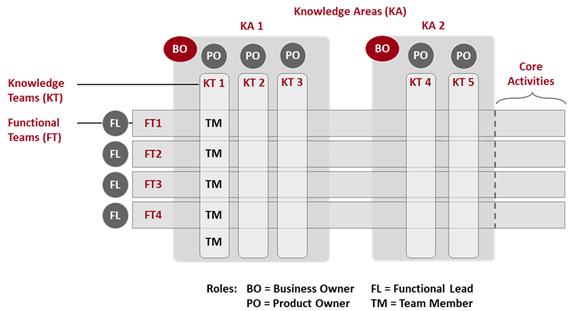New Roles: Who, how, what
acondas on the move (3): Working together to quickly develop new technical and methodological knowledge, test it with customers early on, refine it and make it accessible to all in order to better support the customer in change processes – these are the goals of the new agile set-up at acondas.
Since September 2018, acondas has been set up based on agile team structures. The heart of this set-up are the Knowledge Teams, which are responsible for further developing technical and methodological knowledge in the two key areas of organizational development and digital transformation. The teams also test the new knowledge together with customers and transfer the derived instruments and project techniques into different learning and training formats.
In addition, four Functional Teams take care of the interlinkage between and the development of overarching topics. They work on fundamental questions and ensure the harmonization of technical knowledge developed by the Knowledge Teams.
The new set-up supports the operation of the organization, which has been geared to speed and efficiency. The Knowledge Teams develop the new knowledge content iteratively. In keeping with image of a shared journey: The path to the future will be subdivided into six legs, each pursued in a self-organizing way in short, four-week sprints. The goal of these sprints is the gradual and continuous improvement of each independent, customer-usable intermediate result leading to the desired final product. Five of six sprints have already been finished, the last sprint will be completed in March.
In order to make the new agile set-up work as intended, a precise role allocation with clearly defined responsibilities has been established, in close analogy to setting up agile project teams.

The so-called Business Owners (shown in the illustration as BO) are responsible for several topic areas and, thus, for the added values created within them.
In each of the five Knowledge Teams, a Product Owner (PO) ensures that requirements from the customers’ perspective are transformed into final products. For this purpose, the PO creates a catalogue of requirements (“Product Backlog”) and also provides management and prioritization in meeting those requirements.
The so-called Functional Lead (FL) is responsible for a Functional Team and he takes care that tasks from cross-sectional functions are executed.
The Team Members (TM) assume a dual role in the agile set-up: They belong to a Knowledge Team and also work in a cross-sectional function. This guarantees a close integration of both perspectives as well as an effective processing of any arising tasks.
What is the next leg of the journey? To be continued: “The customer in focus”, tba soon …
